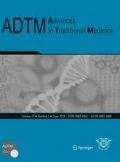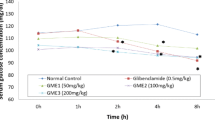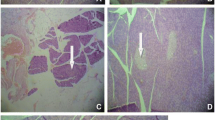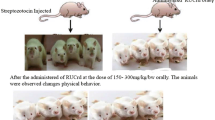Abstract
The present investigation aims to examine the antihyperglycemic potential of Rourea minor (Gaertn.) root in normal and streptozotocin (STZ) induced diabetic rats. The root of Rourea minor (Gaertn.) was extracted using ethanol and water and tested for acute toxicity by up and down staircase method. The aqueous Rourea minor (Gaertn.) water (RMW) extract and ethanolic Rourea minor (Gaertn.) extract (RME) at 200 and 400 mg/kg bodyweight doses were screened for blood glucose lowering capacity in normal and STZ induced diabetic animals; the blood samples were collected from the retro orbital plexus and analyzed for serum glucose (SG) level. Glibenclamide (GLB) was used as a standard. The oral glucose tolerance test (OGTT) was carried out in normal as well as STZ induced diabetic rats whereas, insulin tolerance test was carried out in diabetic rats. At the end of 15 days treatment, serum triglyceride (STG), total cholesterol (STC) and HDL-cholesterol (HDL-c) were assayed by auto analyzer. The results of acute toxicity showed that the animals had good tolerance to single doses of RME/RMW (as high as 3 g/kg) and were non-lethal. The glucose tolerance test in normal rats showed that treatment of RME, RMW (both 400 mg/kg), RME (200 mg/kg) and GLB (0.5 mg/kg) exhibited significant reduction (p < 0.001) in SG level over a period of 120 min of oral administration of root extract. After 15 days of daily oral administration of the extracts to STZ induced diabetic rats, higher dose of RME could reduce hyperglycemia to an extent of maximum 43.14 %. Also the ethanolic extract was more effective in reducing the SG level (OGTT in STZ induced diabetic rats) with improved glucose tolerance compared to an aqueous extract. Both the doses of RME and RMW exhibited significant reduction (P < 0.001) in all tested lipid parameters as compared to diabetic control rats and restored them to nearly-normal values.





Similar content being viewed by others
References
Abdel-Barry JA, Abdel-Hassan IA, Al-Hakiem MH (1997) Hypoglycemic and antihyperglycemic effects of Trigonnella foenum-graecum leaf in normal and alloxan induced diabetic rats. J Ethnopharmacol 58(3):149–155
Ananthan R, Latha M, Ramkumar KM, Pari L, Baskar C, Narmatha V (2004) Modulatory effects of Gymnema montanum leaf extract on alloxan induced oxidative stress in wistar rats. Nutrition 20(3):280–285
Aslan M, Orhan DD, Orhan N, Sezik E, Yesilada E (2007) In vivo antidiabetic and antioxidant potential of Helichrysum plicatum ssp. plicatum capitulums in streptozotocin induced-diabetic rats. J Ethnopharmacol 109(1):54–59
Berson SA, Yalow RS (1963) Antigens in insulin determinants of specificity of porcine insulin in man. Science 139:844–845
Chakrabarti S, Biswas TK, Rokeya B, Ali L, Mosihuzzaman M, Nahar N, Khan AK, Mukherjee B (2003) Advanced studies on the hypoglycemic effect of Caesalpinia bonducella F. in type 1 and 2 diabetes in Long Evans rats. J Ethnopharmacol 84(1):41–46
Chan PK, Hayes AW (1994) Acute toxicity and eye irritancy. Principles and methods of toxicology, 3rd edn. Raven Press Ltd., NY
Eddouksa M, Lemhadri A, Zeggwagh NA, Michel JB (2005) Potent hypoglycaemic activity of the aqueous extract of Chamaemelum nobile in normal and streptozotocin-induced diabetic rats. Diabetes Res Clin Pract 67(3):189–195
Friedewald WT, Levy RI, Fredrickson DS (1972) Estimation of low-density lipoprotein cholesterol in plasma, without use of the preparative centrifuge. Clin Chem 18:499–502
Geoffey VG, Pickup JC (1991) William’s “Text book of diabetes”, 2nd edn. Blackwell Scientific Publications, Hoboken, pp 37–44
Gerich JE (2003) Clinical significance: pathogenesis and management of postprandial hyperglycemia. Arch Intern Med 163(11):1306–1316
Ghosh MN (2008) Toxicity studies. In: Fundamentals of experimental pharmacology. Hilton & Company, Kolkata, p 176
Goldberg RB (1981) Lipid disorders in diabetes. Diabetes Care 4(5):561–572
Kecskemeti V, Bagi Z, Pacher P, Posa I, Kocsis E, Koltai MZ (2002) New trends in the development of oral antidiabetic drugs. Curr Med Chem 9(1):53–71
Maiti R, Das UK, Ghosh D (2005) Attenuation of hyperglycemia and hyperlipidemia in streptozotocin-induced diabetic rats by aqueous extract of seed of Tamarindus indica. Biol Pharm Bull 28(7):1172–1176
Maiti A, Dewanjee S, Jana G, Mandal SC (2008) Hypoglycemic effect of Swietenia macrophylla seeds against type II diabetes. Int J Green Pharm 2(4):224–227
Muruganandan S, Srinivasan K, Gupta S, Gupta PK, Lal J (2005) Effect of mangiferin on hyperglycemia and atherogenicity in Streptozotocin-diabetic rats. J Ethnopharmacol 97(3):497–501
Orhan N, Aslan M, Orhan DD, Ergun F, Yesilada E (2006) In vivo assessment of antidiabetic and antioxidant activities of antidiabetic and antioxidant activities of Grapevine leaves (Vitis Vinifera) in diabetic rats. J Ethnopharmacol 108(2):280–286
Palsamy P, Subramanian S (2008) Resveratrol, a natural phytoalexin, normalizes hyperglycemia in streptozotocin-nicotinamide induced experimental diabetic rats. Biomed Pharmacother 62:598–605
Papaccio G, Pisanti FA, Latronico MV, Ammendola E, Galdieri M (2000) Multiple low dose and single high dose treatments with streptozotocin do not generate nitric oxide. J Cell Biochem 77(1):82–91
Pathak RM, Ansari S, Mahmood A (1981) Changes in chemical composition of intestinal brush border membrane in alloxan induced chronic diabetes. Indian J Exp Biol 19:503–505
Ronald KC, Gordon WC, George KL, Alan JM, Alan MC, Smith R (1994) Joslin’s diabetes mellitus, 13th edn. B.I. Waverly Pvt. Ltd, New Delhi, pp 193–265
Sabu MC, Subburaju T (2002) Effect of Cassia auriculata Linn. on serum glucose level, glucose utilization by isolated rat hemidiaphragm. J Ethnopharmacol 80(2–3):203–206
Schuster DP, Duvuuri V (2002) Diabetes mellitus. Clin Podiatr Med Surg 19(1):79–107
Shirwaikar A, Rajendran K, Dinesh Kumar C (2004) Oral antidiabetic activity of Annona squamosa leaf alcohol extract in NIDDM rats. Pharm Biol 42(1):30–35
Suzuki M, Nomura C, Odaka H, Ikeda H (1997) Effect of an insulin sensitizer, pioglitazone on hypertension in fructose drinking rats. Jpn J Pharmacol 74(4):297–302
Venkatesh S, Reddy GD, Reddy BM, Ramesh M, Rao AV (2003) Antihyperglycemic activity of Carulluma attenuata. Filoterapia 74(3):274–279
Yoganarasimhan SN (1996) Medicinal plants of India, vol 1. Karnataka Interline Publishing Pvt. Ltd, Bangalore, pp 404–405
Acknowledgments
The authors are thankful to Sri. H. V. Dambal, President Soniya Education Trust’s College of Pharmacy, Dharwad for providing the necessary facilities to carry out the study.
Author information
Authors and Affiliations
Corresponding author
Rights and permissions
About this article
Cite this article
Kulkarni, P., Patel, V., Shukla, S.T. et al. Antidiabetic potential of Rourea minor (Gaertn.) root in streptozotocin—induced diabetic rats. Orient Pharm Exp Med 14, 69–76 (2014). https://doi.org/10.1007/s13596-013-0129-z
Received:
Accepted:
Published:
Issue Date:
DOI: https://doi.org/10.1007/s13596-013-0129-z




